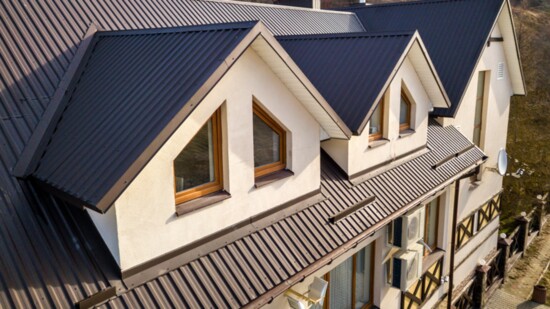If you are looking to make over your home, there may be no better place to start than with your roof.
Metal roofs top the list of what is trending in exterior design. Their popularity, at least in Texas, owes largely to their durability. To wit, the Lone Star State is known as the “undisputable hail capital of America.” So, an impenetrable metal roof with a 50-year warranty certainly makes sense from an investment perspective. According to Jason Valleau, the owner of the Plano-based Ohh Hail Contractors, metal roofs, in the last 15 years, have also evolved into something that pleases the eye. “Nowadays,” Valleau says, “you can order metal roofs in an array of colors and textures. The sky is the limit. There are tons of manufacturers out there, and each has a catalog that runs the gamut in metal roofing. There are metal roofs that perfectly simulate the look of Adobe bricks and those that replicate the old, nostalgic wooden shingles that were banned – in Plano at least – as fire hazards.”
Generally speaking, there are five types of roofing, and each comes in myriad styles and colors. So, the best thing to do is first check in with your homeowners association to see what is allowed. For example, homeowners associations used to typically ban all metal roofs to prevent someone from installing something as unsightly as a tin roof. But some homeowners associations have evolved to make exceptions given how great almost all metal roofs now look.
There are essentially two types of metal roofs: stone-coated steel and standing seam. Standing-seam roofs are those elongated and seamed-together panels of metal that look nothing like shingles. The leading manufacturer of metal roofs is Decra, a company whose style options you can peruse online. Additionally, there are other types of roofs, aside from wooden shingles, that can sustain hail either 1½ or 2 inches large. But even these roofs will fall prey to Texas' extreme weather eventually, especially if the attic or crawl space below them is not adequately ventilated.
In lieu of a metal roof, the four other roofs you might want to consider are made of either composite, rubber, tiles, or asphalt. The most common roofs in Texas are asphalt. For selecting a style, you can check the websites of the two leading asphalt roof manufacturers: GAF and CertainTeed. For perusing rubber-roof styles, you can Google F Wave; and for composite options, DaVinci is the largest manufacturer.
Valleau notes that while getting a new roof can certainly alter the look of your home dramatically, you need not drop the ball before crossing the finish line. In other words, homeowners should consider camouflaging their gutters, drip edges, and the various intake and exhaust vents scattered across their roof. This requires having a professional such as Valleau coat these structures with paint that perfectly matches the color scheme of your roof.
“And why stop there,” Valleau asks, “when whatever has forced you to replace your roof has probably also taken its toll on your siding? In other words, you might want to consider taking a secondary color from your bricks and having your siding custom-painted to accentuate that color.”
“Bottom line, there’s no one shoe fits all,” Valleau says. “But after assessing what needs to be done with your roof and siding, we can come up with a game plan that kills two birds with one stone—protects your home from Texas’ Jekyll-and-Hyde weather while also boosting your property’s aesthetics as long as there’s no pesky homeowners association to get in the way. Even then, we can probably do a workaround.”
“Bottom line, there’s no one shoe that fits all,” Valleau says.
